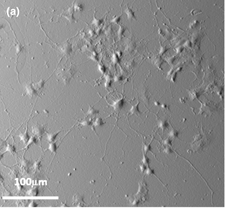Crossref Citations
This article has been cited by the following publications. This list is generated based on data provided by
Crossref.
Hadley, Jacob
Hirschman, Jack
Morshed, Bashir I.
and
Sabri, Firouzeh
2019.
RF Coupling of Interdigitated Electrode Array on Aerogels for in vivo Nerve Guidance Applications.
MRS Advances,
Vol. 4,
Issue. 21,
p.
1237.
Rodriguez Sala, Martina
Peng, Chenhui
Skalli, Omar
and
Sabri, Firouzeh
2019.
Tunable neuronal scaffold biomaterials through plasmonic photo-patterning of aerogels.
MRS Communications,
Vol. 9,
Issue. 4,
p.
1249.
Sala, Martina Rodriguez
Skalli, Omar
Leventis, Nicholas
and
Sabri, Firouzeh
2020.
Nerve Response to Superelastic Shape Memory Polyurethane Aerogels.
Polymers,
Vol. 12,
Issue. 12,
p.
2995.
López-Iglesias, Clara
Barros, Joana
Ardao, Inés
Gurikov, Pavel
Monteiro, Fernando J.
Smirnova, Irina
Alvarez-Lorenzo, Carmen
and
García-González, Carlos A.
2020.
Jet Cutting Technique for the Production of Chitosan Aerogel Microparticles Loaded with Vancomycin.
Polymers,
Vol. 12,
Issue. 2,
p.
273.
Schimper, Christian B.
Pachschwoell, Paul S.
Hettegger, Hubert
Neouze, Marie-Alexandra
Nedelec, Jean-Marie
Wendland, Martin
Rosenau, Thomas
and
Liebner, Falk
2020.
Aerogels from Cellulose Phosphates of Low Degree of Substitution: A TBAF·H2O/DMSO Based Approach.
Molecules,
Vol. 25,
Issue. 7,
p.
1695.
Rodriguez Sala, Martina
Chandrasekaran, Swetha
Skalli, Omar
Worsley, Marcus
and
Sabri, Firouzeh
2021.
Enhanced neurite outgrowth on electrically conductive carbon aerogel substrates in the presence of an external electric field.
Soft Matter,
Vol. 17,
Issue. 17,
p.
4489.
Wu, Ting‐Ying
Wu, Chih‐Yu
Christy, Jane
Chiang, Yu‐Chih
Guan, Zhen‐Yu
Yu, Jiashing
and
Chen, Hsien‐Yeh
2021.
Vapor‐Phase Fabrication of Cell‐Accommodated Scaffolds with Multicomponent Functionalization for Neuronal Applications.
Advanced Materials Interfaces,
Vol. 8,
Issue. 24,
Ferreira-Gonçalves, Tânia
Constantin, Carolina
Neagu, Monica
Reis, Catarina Pinto
Sabri, Firouzeh
and
Simón-Vázquez, Rosana
2021.
Safety and efficacy assessment of aerogels for biomedical applications.
Biomedicine & Pharmacotherapy,
Vol. 144,
Issue. ,
p.
112356.
Mitchell, Katherine Elizabeth
Aryal, Makunda
Allison, Steve
and
Sabri, Firouzeh
2021.
Remote optical detection of geometrical defects in aerogels and elastomers using phosphor thermometry.
Optical Materials,
Vol. 119,
Issue. ,
p.
111378.
Sala, Martina Rodriguez
Skalli, Omar
and
Sabri, Firouzeh
2022.
Optimal structural and physical properties of aerogels for promoting robust neurite extension in vitro.
Biomaterials Advances,
Vol. 135,
Issue. ,
p.
112682.
Ghimire, Sagar
Sala, Martina Rodriguez
Chandrasekaran, Swetha
Raptopoulos, Grigorios
Worsley, Marcus
Paraskevopoulou, Patrina
Leventis, Nicholas
and
Sabri, Firouzeh
2022.
Noninvasive Detection, Tracking, and Characterization of Aerogel Implants Using Diagnostic Ultrasound.
Polymers,
Vol. 14,
Issue. 4,
p.
722.
Ma, Tienli
Tsai, Chiehming
Luo, Shyhchyang
Chen, Weili
Huang, Yuching
and
Su, Weifang
2022.
Chemical structures and compositions of peptide copolymer films affect their functional properties for cell adhesion and cell viability.
Reactive and Functional Polymers,
Vol. 175,
Issue. ,
p.
105265.
Rodriguez Sala, Martina
Ghimire, Sagar
Raptopoulos, Grigorios
Paraskevopoulou, Patrina
and
Sabri, Firouzeh
2023.
Investigation and characterization of time-dependent degradation of X-Ca-alginate aerogels for biomedical applications.
Journal of Materials Science,
Vol. 58,
Issue. 30,
p.
12331.
Sabri, Firouzeh
2023.
Springer Handbook of Aerogels.
p.
1471.





